What is śiraśāsana (head-stand pose)
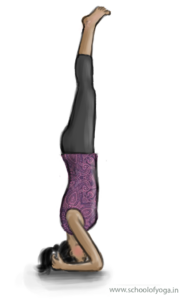
Śiraśāsana or Head-stand Pose is an āsana where the practitioner balances the entire body one the head, using the cupped hands and elbows as support. This āsana is an advanced āsana and must be learned under the supervision of an expert yoga practitioner.
How should one practice śiraśāsana? (Should be learned under supervision)
- Sthithi (starting) position: Spread a thick cloth pad against a wall.
- Kneeling in front of the pad, bend forward and place hands on the spread to form a “V” at an angle of approximately 60 degrees. The palms should be turned facing the body with fingers interlaced.
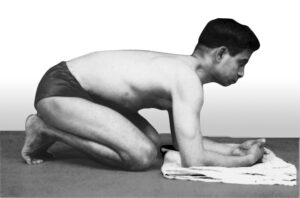
Yogacharya Sundaram demonstrating Sthithi (starting) position in 1920s - Place top of the head firmly on the pad and in the cradle of interlaced hands so that palms support the back of the head.
- Slowly lift knees and move legs up so that torso rises till it is vertical with the head. Leveraging with elbows, shoulder and lower back muscles, lift off the ground smoothly.
- As torso rises, keep knees together. Get into an upside-down position.
- Stabilise position and straighten legs. Keep the neck rigid.
- After sufficient practice one could begin doing this exercise away from a wall. In this case after lifting legs off the ground, fold them at the knees for balance before straightening.
- The body should be held straight and rigid in final position.
- Maintain normal breathing.
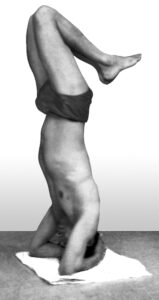
Yogacharya Sundaram demonstrating intermediate Shirasasana (1920s) - Focus on the movement of consciousness (citta) in the brain.
- Come down to sthithi (starting) position by reversing the cycle. Relax.
- Importantly, wait at sthithi (starting position) for blood supply to normalise before getting up.
- Start with 10 secs. initially. Normal cycle is 3 to 20 minutes. However, one can also split the practice into 2 periods of 3 to 10 minutes each with a break of 2 minutes.
- The dṛṣṭi (gaze) recommended is ūrdhva-dṛṣṭi (open sky gaze).
What are the benefits of śiraśāsana practice?
- This āsana infuses blood pregnant with oxygen into the central nervous system. As a result, brain cells are invigorated, waste cleaned and removed. The oxygen supply stabilises brain’s metabolic activity. Therefore, this exercise is good for improvinf overall brain function and development.
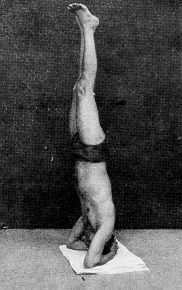
- The eyes, eye muscles, retinal nerves are flushed with oxygen impregnated blood. Hence, very good for health of the eye.
- This āsana energises the pituitary glands, hypothalamus and thalamus which controls the functioning of testes in men and all the endocrine organs such as the thyroid and adrenaline glands.
- The downward force of blood also helps in infusing blood to the ears, eyes, mucous tissues and salivary glands.
- The focus on breathing at the throat balances ear pressure.
- Good for maintaining body fat balance since pituitary also regulates the balance between water and salt in body fluids through the kidneys.
- Also, the downward pressure of the colon contents increases peristalsis and cures constipation.
- The cartilage in the spine gets exercised and rejuvenated because of reverse pressure on the spine.
What are the possible contraindications of śiraśāsana?
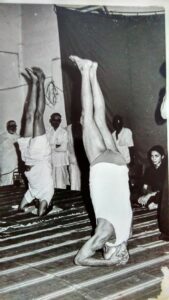
- If you have any form of back ache, do not attempt this āsana without adequate supervision and support.
- People with cardiac problems, lower back problems and circulatory disorders should not attempt this āsana.
- Śiraśāsana should not to be done by people having neck ailments like cervical or lumbar spondylosis or arthritis.
- People with kidney ailments, hernia etc should avoid this āsana.
- This āsana should not be practiced during menstruation or pregnancy.
Some noteworthy points of śiraśāsana.
Internal Links: Dharma (conditioning), Stress and Situational Awareness, Prana, Asana sequence, Asana schedule, Asana Focus or gazing, Pranayama, Hatha Yoga Pradeepika
External Links: Prana, Chakra, Pancha Tattva, Pancha Prana, Pancha Kosha, Nadi,
- Ensure that you are physically fit before performing this āsana.
- Do not relax the abdomen. It can cause the walls to collapse and tearing of the inguinal hernia.
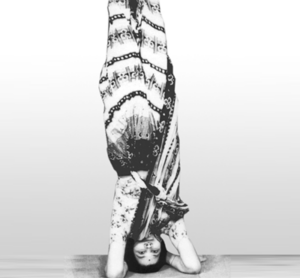
- Do not relax the neck, shoulder and back when performing the asana as this could lead to accidents.
- Needless to say, this āsana will also benefit the thyroid. Indeed, this āsana is indispensable for bringing balance to the endocrine system.
- When the āsana is being performed, there will be an increased flow of oxygen impregnated blood to the brain. Consequently, there is increased pressure within the head. So, do not perform this āsana for long duration initially. Allow the body to acclimatise itself to the increased blood flow and then increase the duration.
- Since the blood supply to the head is increased dramatically, do not rise off the ground immediately after completing this āsana. Quick movement could result in loss of stability and balance. Come to sthiti (starting) position and wait for the blood supply to normalise before standing up.